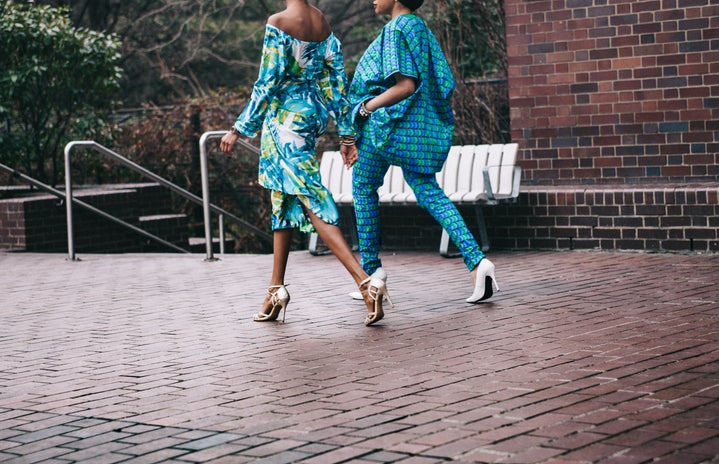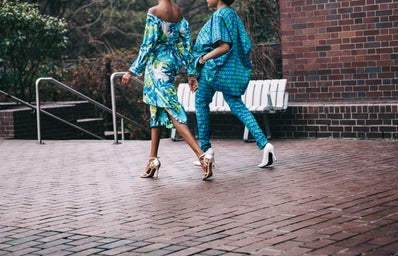Shoes; we either have more than 20 pairs and are always buying more or only have three pairs that are rotated out every so often. They are a part of our daily lives whether we think about it or not. They are a societal norm for cultures in the United States. The shoes we wear have an impact on our day. Are they a comfortable sneaker that will motivate you to go to the gym later? Are they your favorite fall bootie to give you some bounce in your step? They could even be that gorgeous pair of pumps you love to look at, but that make your feet swell two sizes at the end of the day.
Working in a shoe store I get to experience every different type of customer and find out their different needs from different shoes. Even if someone falls into the category of “not caring” about shoes, the shoes that they are wearing on their feet have had a long history with fashion. Every shoe has a story, but heels in particular have come a long way from where they started.
There is some debate as to when heels were “invented”. Some say that they were worn as early as Ancient Egyptian times, but others disagree and say that the traditional heel that we know today was first worn in the 16th century. Egyptians are typically known for their flat sandals with straps, but “Egyptian butchers also wore heeled shoes for practical purposes, that is, in order to keep their feet clean of any blood while slaughtering animals”. These could have been the first kind of primitive high heels.
Another source says that “heels [were] worn by upper-class citizens for ceremonial purposes”. The lower classes of Ancient Egypt typically wore no shoes at all. The wealthy in the 16th century were the ones who held the higher status symbol that could wear the new trend for that era. The high heels were worn by both men and women. It is said that noblewoman Catherine de Medici a Franco was the first person to wear heels to impress guests at her wedding. She was 14 years old so the heels gave her much needed height. This may be historically inaccurate because “the development of heels did not begin to come about until the late 1580s”.
We also do not know who is credited with the invention of heels because of the discrepancies in time period and styles. “It is believed the design of high heels transpired purely by accident and as the result of repair work on heels that would gradually be built up into high heels”. Some historians believe that the high heels of today originated from chopines in the 1400s. These platform shoes were worn by the women of this time period. The platforms reached heights of about 18 inches so these women were walking tall to impress “clients”. Prostitution was legal at this time so the height of the heels gave you’re your profession. This trend of the chopines is believed to have been started by Venetian prostitutes. Soon they caught on with the wealthy. These shoes were so uncomfortable and unstable if you wore them it showed how wealthy you were in that you did not have to walk or work. “In later years, the Chopine was often encouraged by spouses because they were difficult to walk in. This meant that the shoe would impede the woman from wandering out to engage in liaisons with other males”.
Until about 1660 men and women’s shoes remained pretty similar in style. Once this time of similarity ended the shoes that women were wearing became less practical and more ornate where they included “silks, brocades, braids, and velvet”. Many shoes on display in museums display these shoes with their fine embroidery and craftsmanship. These were the styles of women who could afford them and not everyone was able to. Around 1670 King Louis XIV of France started to either cover or paint all of the soles and heels of his shoes red. They were not produced for anyone else besides him so his subjects would look for knockoffs. We now see where the famous red soles and heels that Christian Louboutin followed in the footsteps of originated from. Nicholas Lestage was the shoe maker for King Louis XIV and would create “decorative battle scene[s]” on his shoes.
Until this time both men and women wore heels, but in the 18th century “men deemed them impractical”. Even though men’s heels were broad and sturdy to try and be practical for their labor intensive jobs, they were rejected. While this was happening the heels on women’s shoes “became tapered and decorative”. In 1750 the pompadour heel was worn even though they were hard to walk in. They had a beautiful narrow heel and seductive quality so no one minded the tottering affect they had on women’s walks. These shoes also had women taping their feet to look smaller. This caused them to faint in court.
There was a flat period during the 1840s where the style that was popular was the slipper. This was during the French Revolution where Napoleon banned high heels. Only the rich were able to afford them at this point and Napoleon wanted to establish equality. Even though heels were banned at this time, Marie Antoinette wore two inch heels to her evacuation. Also during this time Queen Victoria of England wore “the first pair of high heeled boots”.
Ten years later the heel returns even though it is still very short. Advertisers now claim that heels are beneficial and that they help with back aches and walking correctly. The invention of the sewing machine around this time helps to create variety for the heels being produced. “ It wasn’t really until the roaring 1920s when hemlines left the ground that heeled shoes became more decorative than merely functional, playing with new strap designs and different kinds of fabrics.”. In the 1920s heels started to become mass produced. Since the hemlines were shorter, heels tended to be high and slender to elongate the legs. Once the depression hit in the 30s heels had lower and wider heels. In 1933 Salvatore Ferragamo invented the wedge. These wedges could tower as high as the heels, but with more stability.
World War II started in 1939. With the start of the war came soldiers having pinups in their rooms. These women in the pinups were always wearing heels to elongate their legs. They would only be standing in them for the picture so they tended to be higher than the average every day heel. Back home because of the shortage of materials heels back home were “high and wide in width”. Since most of the men were fighting in the war many women had to take over their jobs which locked in the idea of the shoes having to be sensible.
Influenced by the higher heels worn by the models by 1953 we had the stiletto heel. Christian Dior brought this style back after World War II by adding height to the court shoe of the 19th century. Roger Vivier worked for Dior and is credited with inventing the stiletto. He used plastic to create the strong narrow heel that he called “the needle”. In the 1960s stilettos start to become unpopular because of the feminist movement. Women were now wearing heeled boots to go with their miniskirts. After the heeled boots came the platform shoes worn by men and women in the 70s featuring bright colors and patterns.When the 80s and 90s came, high heels came back. The women of the 90s were powerful and felt that the heels communicated that power to the world. To take a jump from that time, in 2006 Manolo Blahnik introduced the heelless high heels. To compete with Blahnik, Lyall Coburn created the reverse high heel. These “scary beautiful” shoes are a wearable art piece that Coburn created “to ‘challenge current beauty ideals by a big and unexpected new beauty standard’”. In 2010 Alexander McQueen presented his “armadillo heels” design that Lady Gaga enjoys wearing for concerts and red carpets.The words designer and artist now are intertwined in the world of high heel art with new creations happening frequently. Christian Louboutin, usually known for his famous posh red bottomed shoes, even threw his hat into the ring by creating 8-inch heels where the shoe is completely upright like a ballerina pointe shoe. While these beautiful shoes are completely unwearable, they make for wonderful pieces of art. Typically throughout history shoes were used in a practical manner and were no created specifically to be displayed in museums. There were those types of shoes like the pompadours that were very uncomfortable and almost impossible to walk in, but people still did it. They were admired while they were on the wearer’s feet and not on a pedestal or behind glass case.
Since the early 2000s designers and artists have pushed the boundaries on what is wearable. They are taking more of an architectural turn and using unconventional materials. 3D printing was invented in 1986, but has since seen a big spark in popularity recently. It has now become more accessible than ever and designers are taking full advantage of this and incorporating this new construction technique into their clothing and more importantly shoes.
Modern day designers are looking back to the styles of the past to draw creativity for their designs of today. We have seen modern redesigns of the classic chopines from the 1400s with different twists like “flooding” at the base and different embellishments. Designers are also gathering influence from the platform boots of the seventies by taking them to new heights. We now have flatform and platform sneakers and booties that tower over what we have seen in the past.
“High heels have been around for so long, and reinvented by so many different designers and skilled cobblers, that now we also consider them works of art.” Today, heels are a part of a $40 billion dollar industry. Even if you do not own a single pair of heels, there is no denying that these pieces of reformed history have an effect on our lives.


